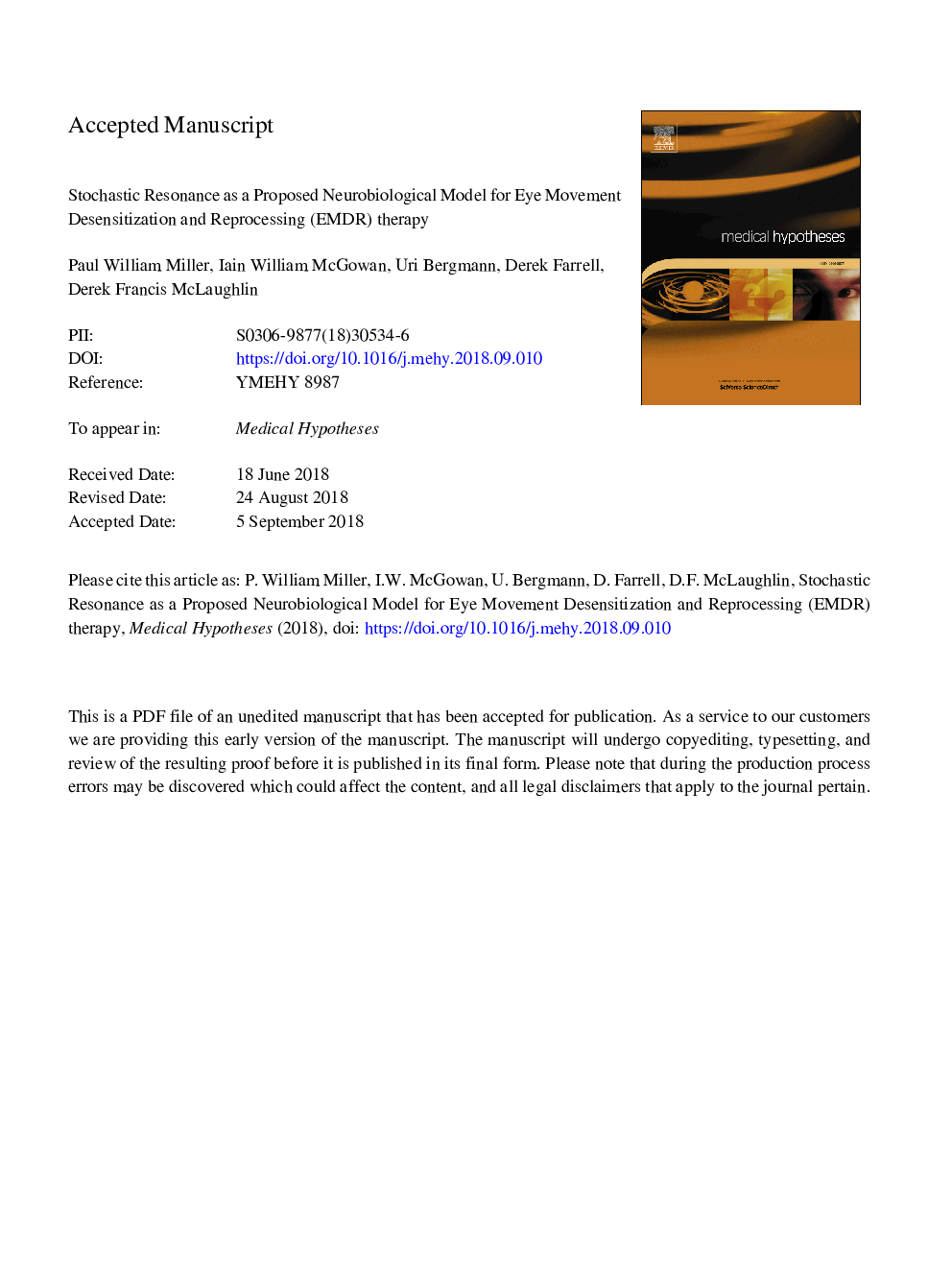| کد مقاله | کد نشریه | سال انتشار | مقاله انگلیسی | نسخه تمام متن |
|---|---|---|---|---|
| 11025781 | 1666517 | 2018 | 33 صفحه PDF | دانلود رایگان |
عنوان انگلیسی مقاله ISI
Stochastic resonance as a proposed neurobiological model for Eye Movement Desensitization and Reprocessing (EMDR) therapy
دانلود مقاله + سفارش ترجمه
دانلود مقاله ISI انگلیسی
رایگان برای ایرانیان
موضوعات مرتبط
علوم زیستی و بیوفناوری
بیوشیمی، ژنتیک و زیست شناسی مولکولی
زیست شناسی تکاملی
پیش نمایش صفحه اول مقاله

چکیده انگلیسی
EMDR therapy is recommended in several guidelines in the International field of psychological trauma. The dual attention stimuli/alternating bilateral stimulation (DAS/ABS) element of EMDR therapy has no proposed mechanism of action agreed upon, which explains the rapid shifts in cognitions and dysfunctional traumatic memory networks that are central to its observable efficacy. This paper discusses an innate, biological mechanism found in biological systems, including the human nervous system that may explain the efficacy of DAS/ABS. This mechanism is stochastic resonance (SR). SR is observed to make unintelligible, subthreshold signals intelligible and facilitates signal transmission. It provides a potential mechanism for discrimination and the selective focusing of attention, which are important factors in effective psychotherapy for the psychologically traumatised individual. The body/mind complex aims to achieve the functional encoding of memories in the neocortex and a key structural crossroads in this process is the thalamus. Activity in the thalamus is decreased in Post-Traumatic Stress Disorder (PTSD) compared to non-PTSD patients and a form of 'gating' is known to occur at the thalamic level. This 'gating' is adaptive and it is postulated to protect the higher neocortical systems in times of trauma. Although the model is initially somewhat counterintuitive, Stochastic Resonance; a form of random 'noise', can be considered 'helpful randomness' and when present in the thalamus SR can help filter and control sensitivity to incoming signals; helping to discriminate what is communicated. Naturally occurring SR is normally present as a result of descending cortico-thalamic activity, but appears attenuated as a result of exposure to trauma. The view of 'noise' in the current era of cell phones and High Definition is generally negative with science going to significant lengths to clean up signals: i.e. removing noise from them. We do not want white noise in our music or during our cell phone calls. However, some researchers invite us to consider that not all noise is bad and the downward cortico-thalamic 'noise' is an example of this category of 'helpful noise'. This paper will discuss the potential role of SR, as the mechanism by which DAS/ABS generates a random (stochastic) signal, facilitating a return to functional memory processing, where there is a lack of naturally occurring noise from the descending cortico-thalamic connections because of exposure to trauma. Modelling the mechanism as SR will facilitate further study into EMDR therapy and this will hopefully encourage perspicacity, where there has previously been derision.
ناشر
Database: Elsevier - ScienceDirect (ساینس دایرکت)
Journal: Medical Hypotheses - Volume 121, December 2018, Pages 106-111
Journal: Medical Hypotheses - Volume 121, December 2018, Pages 106-111
نویسندگان
Paul William Miller, Iain William McGowan, Uri Bergmann, Derek Farrell, Derek Francis McLaughlin,